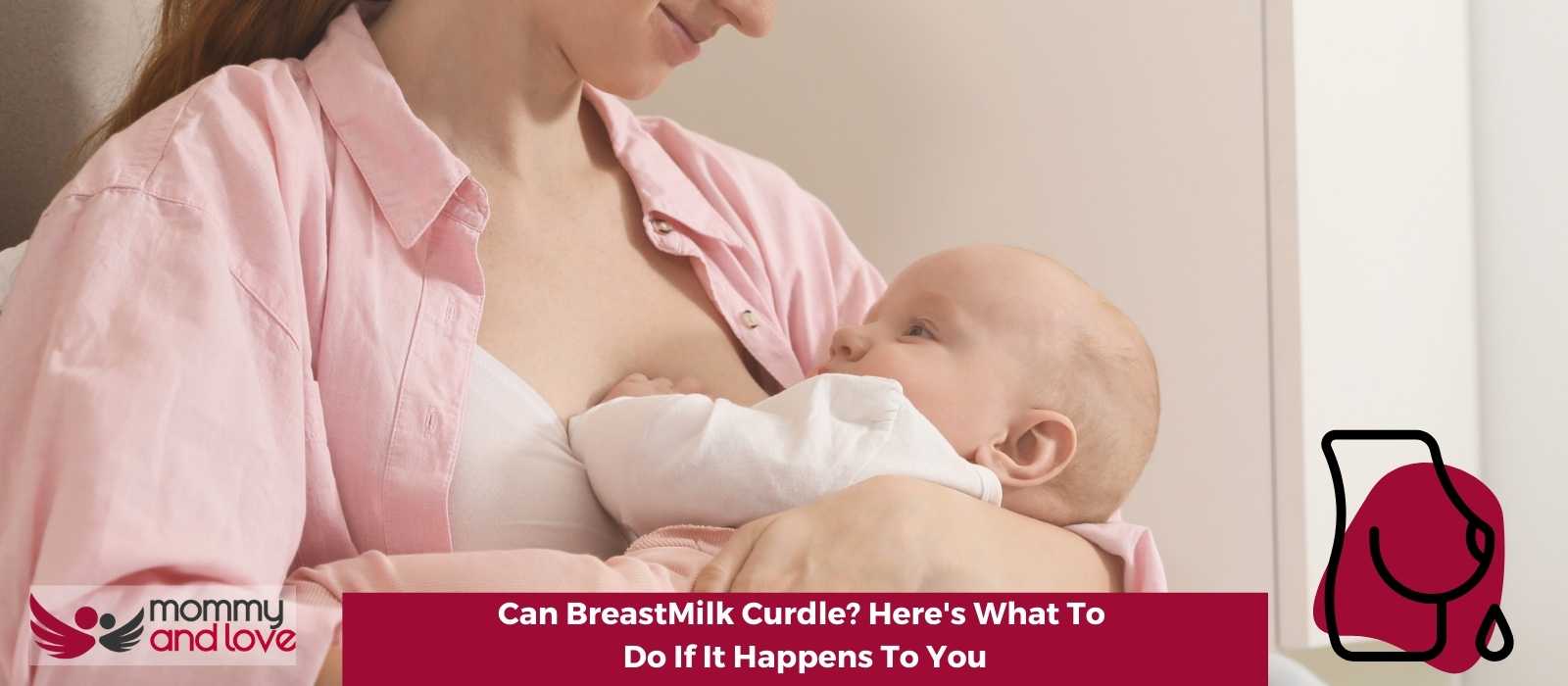Breast Milk is just like any other milk, so yes, it can curdle and expire. While inside your breast, you can be assured that your milk will not spoil, however, as soon as you express your milk, it’s important to ensure correct storage guidelines to prevent spoilage.
When handled correctly, expressed breastmilk will be good for 4-6 hours at room temperature, up to 5 days in the refrigerator and 6 months in the freezer. But what if you go to the fridge and find that the milk stored there since yesterday looks a bit chunky? Don’t worry: it’s completely normal.
Unlike the milk you buy at the store, human milk is not homogenized. Expressed milk will separate, with the fatty component settling at the top, which can give a curdled appearance.
Thawed milk can appear as yellowish, milky, lumpy or a sticky curd that resembles cottage cheese. Does this mean it’s spoiled?
Not at all! Often a quick swirl will mix the fatty milk back with the watery milk.
Baby Spits Up Curdled Milk

Another time moms tend to panic is when baby spits up curdled milk.
A baby bringing up curdled milk is typically caused by a combination of time, the acidic nature of your baby’s stomach fluid. It’s perfectly normal for baby to spit up a little milk with a curdled appearance.
Of course, sometimes curdled milk really is just spoiled milk- if you haven’t followed proper procedure in expressing and storing your milk. It could be down to the temperature at which breast milk or formula is stored.
Breast pump milk that is left out at room temperature for too long will become curdled, as will milk that has been warmed for too long in the microwave, under running warm water or on the stove.
Milk might also curdle if you don’t use it quickly enough after a pumping session. Always use within 4 hours at room temperature, 5 days if stored in the fridge or 6 months if frozen. I
f you notice this happening frequently, it’s probably best to store your breast milk in smaller amounts so that you don’t have to waste any.
What Does Curdling Mean?
Have you ever poured a carton of milk into your cereal and noticed that it had little clumps in it? Maybe the milk was old, or maybe it wasn’t. Thawed frozen milk, even when stored properly, can become curdled if not fully defrosted or mixed properly.
Curdling is a term that refers to the separation of different elements in breast milk storage. Breast milk is not homogenized, meaning that larger fats will separate from smaller fats, all fats will separate from proteins and proteins will separate from water.
In time, a gradient of heavier-larger molecules on the bottom and smaller-lighter molecules on the top will appear. This is completely normal and natural, and will not present any problems for your little one.
Curdled milk is what you get when lumps form in smooth milk. Although the clumps form in spoiled milk, the chemical reaction that causes curdling also occurs in fresh milk or stored breast milk, under the right conditions. The protein molecules, mainly casein, repel each other so they naturally distribute evenly through the liquid.
Can Frozen Milk Curdle?

Breast milk is made up of different layers of water and fat, with protein floating around in there.
When you refrigerate breast milk in a deep freezer, the protein molecules clump up together, making a tangled mess of protein called curds that may simply be untangled if you gently swirl the stored milk when thawed.
These curds are easily separated from the rest of the liquid by a gentle swirl or you can just shake the bottle and they’ll mix right back in! The milk is still safe to drink.
Can Breast Milk Curdle?
The answer is, yes, breast milk does curdle.
Curdling is what happens to breast milk when it separates into different components. It’s not homogenized, so in time, the larger fats will separate from smaller fats, all the fats will separate from proteins and the proteins will separate from water. This is normal and you can stuill feed this breastmilk to your baby.
After feeding a baby, you’ll probably notice that their spit-up is lumpy and white. “Curdled milk” is on everyone’s mind, whether it’s actual curdled milk or not. Again , this is completely normal.
On the other hand, if, for example, you’ve forgotten to store your breastmilk in the refrigerator and notice curdling, it may be that the milk is spoiled on that occasion. You can give the breastmilk a sniff- if in doubt toss it out.
Why Does My Expressed Breastmilk Curdle?
There are a number of reasons why your expressed milk can curdle.
The first reason applies to milk that curdles in your baby’s tummy: babies’ spit-up becomes curdled when milk from breastfeeding or formula mixes with the acidic stomach fluid. Additionally, if there are stomach acids in the brook and spit-up, it will become very curdled. This is nothing to worry about.
The second applies to milk that curdles in storage; this occurs when your expressed milk separates in storage, this is a normal process. Because it isn’t homogenized, when stored in the refrigerator, your expressed breast milk will separate into layers — a cream layer at the top and a watery layer at the bottom, according to Kelly Mom.
The cream layer contains all of the fat and proteins. You may even notice that the milk takes on a clumpy consistency.
If you ever notice that your expressed breast milk looks a little lumpy, don’t worry — it’s totally normal! When we express milk from our breasts, it’s in small amounts, so it doesn’t have time to fully separate.
It’s only when you store milk for longer periods of time in the fridge or freezer that it has enough time to completely separate into layers. A gentle swirl should do the trick.
Why Is My Baby Spitting Up Curdled Milk?
Does your baby spit-up curdled milk? We know how awful it can be when your little one looks like she’s vomiting up curdled milk, but’s not as bad as it looks. Babies’ spit-up becomes curdled when milk from breastfeeding or formula mixes with the acidic stomach fluid.
The truth is that spit-up, just like vomit, can contain stomach acid. And when the milk your baby consumes mixes with stomach acid, it can sometimes appear curdled.
Curdling happens when there’s too much acid in the digestive tract, and babies can easily produce too much of it.
If your baby is spitting up curdled milk, it’s not so much a matter of how long it’s been there as what it’s been up to. When babies spit up, they’re throwing up the contents of their stomachs, usually due to irritation or too much food or liquid.
Here’s why your baby might be spitting up curdled milk — and what you can do about it.
- In most cases, baby spit-up is either normal (for babies) or a condition that improves on its own. Babies’ spit-up becomes curdled when milk from breastfeeding or formula mixes with the acidic stomach fluid. If your baby is spitting up more than usual and seems fussy, it may be a sign of reflux — a condition in which the stomach contents back up into the esophagus.
- The other and most common reason — at least for newborns — is just that their digestive system needs more time to develop.
There are a few things you can do to help your baby through this stage:
1. Burp after every feeding
This can help keep your little one from swallowing air, which can cause spit-up.
2. Hold them upright after feedings
If you nurse or bottle-feed, try burping your baby before switching sides (if you’re nursing) or finishing the bottle (if you’re using one). This can help keep more milk from coming back up.
3. Keep them upright for 20-30 minutes after eating
Babies digest better when they’re sitting in an upright position as opposed to lying down or sleeping on their backs. Try keeping your little one in a swing for a bit after feeding time.
Is Curdled Breast Milk OK?
Separating is normal! If you’ve noticed separation in your breast milk, you’re not alone. In fact, it’s normal for the molecules in breast milk to separate into layers. This happens because there are two types of protein in breast milk: fat-soluble proteins, which are heavier and larger, and water-soluble proteins, which are smaller than fat-soluble ones.
There is no need to strain, milk separation can be rectified by gently swirling the milk to bring it back together again.
However, if the milk smells sour or off, that’s a sign it’s gone bad and should be tossed.
Does expressed breast milk separate when refrigerated
Expressed breast milk will separate if you refrigerate it, and that’s totally normal. It may separate into a creamy-looking layer and a lighter, more milk-like layer. That’s totally normal, and it’s actually a sign that your breast milk is fresh and healthy.
In fact, breast milk keeps its shape better than cow’s milk does, so you may even find that your breast milk separates into layers after it’s warmed back up—making a tangled mess of protein called curds. Don’t worry—it’s still safe to drink!
Conclusion On Breast Milk and Curdling
You may find it frustrating if your baby spits up curdled milk, but be assured that it is unlikely to be a health issue. Do consult a doctor however if your baby seems to be distressed or you suspect reflux.
In the meantime, make sure you’re following storage guidelines for expressed breast milk so that it will last up to six months in the freezer. Separation in breastmilk is completely normal, however, if, for example, you have forgotten to store your breastmilk properly and it appears curdled, use caution.
Spoiled breastmilk will have a distinct smell. Perform the sniff test if you are unsure if your breastmilk has spoiled, and if in doubt, always toss it.

This article was written by Sandra Baker – full time writer and the mother of four amazing kids (including twins!)
She’s also a breastfeeding counselor and has spent years helping new parents learn how to care for their children. When she’s not writing or caring for her children, Sandra likes to spend time reading and taking walks with her husband.




